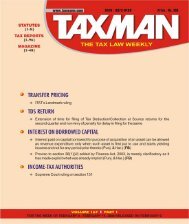news round up - Taxmann
news round up - Taxmann
news round up - Taxmann
- TAGS
- news
- round
- taxmann
- taxmann.com
Create successful ePaper yourself
Turn your PDF publications into a flip-book with our unique Google optimized e-Paper software.
2010] ANALYSIS ON PROSPECTS OF IMPLEMENTATION OF GST IN INDIA 131<br />
should primarily be of a nature of indirect taxes, either on s<strong>up</strong>ply of<br />
goods or on s<strong>up</strong>ply of services. On the contrary, the taxes or levies not<br />
specifically related to s<strong>up</strong>ply of goods or services should not form<br />
part of the consolidated levy. Also, those taxes should be part of the<br />
transaction chain which commences with the import/manufacture/<br />
production of goods or provision of services at one end and the<br />
consumption of goods and services at the other. This subsumation<br />
should result in free flow of credit at the Central as well as the State<br />
levels.<br />
The paper also prescribes a concept of ‘revenue fairness’, which<br />
needs to be adopted and followed among all States of the Indian<br />
federal polity, in order to promote and establish a healthy and<br />
competitive environment for all stakeholders. At present and to<br />
begin with, 8 major taxes are being proposed to be subsumed into the<br />
CGST, while 6 taxes are being proposed to be subsumed within the<br />
SGST. In regard to which, it is stated that the said paper does not<br />
prescribe or indicate any specific criteria or guiding principle for<br />
subsumation of taxes; however, it is felt that this being the launch of<br />
the GST regime, in future various other taxes not presently included<br />
would be included within the consolidated levy. The fundamental<br />
challenge or difficulty posed through integration of taxes would be<br />
to effectuate a constitutional amendment in order to settle the taxing<br />
power of the States vis-a-vis the Centre. However, it is felt in-principle<br />
that subsuming of taxing levies into a consolidated levy seems to be<br />
a suitable option as per the basic tenets of fiscal federalism.<br />
(ii) GST rate structure - India is presently following a dual rate structure,<br />
wherein excise duty is being levied at a typical 8/16 per cent while the<br />
State VAT is being levied at 4/12.5 per cent. This model of dual rate<br />
structure has proved successful within our fiscal framework; hence,<br />
it is imperative to carry forward the same within the GST framework<br />
as well. In fact, the paper has indicated a dual rate structure, which<br />
would have three further variants, namely, a basic rate (for necessary<br />
items and items of basic importance), a standard rate (for goods<br />
in general) and a special rate (for precious metals and exempted<br />
items).<br />
Currently, the cumulative tax incidence of the element of excise duty<br />
and State VAT works out to be between 22 per cent - 24 per cent of<br />
the retail sale price. Hence, it is expected that the aggregate rate of<br />
duty for GST would be worked out in such a fashion that it brings<br />
down the element of tax from the present rate of 24 per cent<br />
(maximum) to a much lower rate, thereby assisting in bringing down<br />
the tax burden. Such step would also lead to an additional benefit;<br />
apart from reduction in rate, determination of base rate would<br />
GOODS & SERVICES TAX CASES ❑ JANUARY 20 - FEBRUARY 4, 2010 ◆ 41











![“FORM NO. 3CEB [See rule 10E] Report from an ... - Taxmann](https://img.yumpu.com/45480232/1/190x245/form-no-3ceb-see-rule-10e-report-from-an-taxmann.jpg?quality=85)





